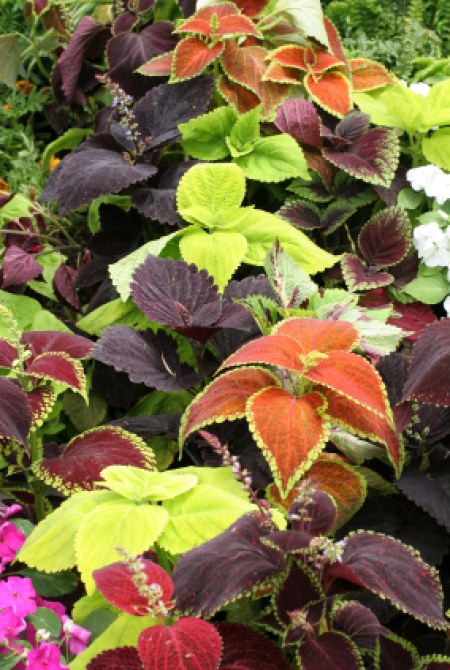
Coleus has remained a popular plant ever since it rose to favor during the Victorian age. The leaves of this inexpensive and versatile plant come in a bewildering array of colors, patterns, shapes, and sizes. Sometimes called the "poor man's croton", coleus easily competes with the croton in brightness and color, but it's a whole lot easier to grow.
Coleus (Solenostemon hybrids)
Life cycle: Very tender perennial.
Hardiness: Zones 10 to 12.
Height: 6 inches to 5 feet (the average height is 1-2 feet tall).
Spread: 1 to 3 feet wide.
Foliage: Colorful foliage with purple spikes of flowers (many people pinch them off).
Exposure: Sun to part shade; the intensity of light has a direct effect on the intensity of its foliage. Some varieties may produce their best color in light shade, while others look best in bright sun. Some experimentation may be necessary to find out what your plant likes best.
Soil: Moist, well-drained soil.
Propagation: Seeds (easily obtainable) or stem cuttings. A 3 or 4 inch long stem cuttings will readily produce roots, even in a glass of water.
Maintenance: Pinching (removing) the terminal bud of each shoot when it reaches three to four inches in length will encourage side branching, prevent flowering, and produce more beautiful foliage.
Coleus has a longstanding and well-earned reputation as being a plant almost anyone can grow. Morning sun with afternoon shade works well for most varieties, although many of the newer hybrids (usually with "sun" or "solar" in their names) have been bred to handle more light.
As a general rule, most coleus will tolerate some sun, but their colors will look their best in partial shade. Deep colors like black and burgundy will look more intense, and whites and creams will stay brighter. If your plants are growing in containers, try moving them to different locations to see what works best.
Coleus grown in the sun prefers consistent amounts of moisture, but when grown in shade it shows tolerance for drier soil. In the hottest parts of the country, plants may need watering every day. Leaf drop is usually a good indicator that the plants are not getting enough water. Though they sometimes wilt in heat, coleus will recover quickly once you give them a drink. Applying a couple of inches of mulch around your plants will help conserve moisture.
Despite all of the color it provides, coleus doesn't need a lot of feeding. In fact, even without fertilizer coleus tends to be a vigorous grower. To get the best leaf color apply a dose of balanced, 10-10-10 water-soluble fertilizer early in the spring, and if necessary, follow up with one more mid-season. When the plants are small, pinch the stems back by about a third to keep them compact. Deadheading any flowers you see (they are small and insignificant anyway) will keep the plants growing strong.
Coleus make nice house plants as long as they receive sufficient light and food. Basic care indoors includes the following:
Coleus is technically a tender perennial - a very tender perennial. Cold weather causes stunted growth and plants seem to turn to mush when there is even the slightest rumor of frost in the forecast. In the spring, hold off on setting plants out until the soil temperatures stay above 55 degrees F. When it's safe to set out your tomato plants, it's safe for coleus, too.
Coleus is incredibly versatile in the garden. Use it in container arrangements, in borders or as specimen plants in mixed beds. These plants are vigorous growers. Make sure you give them plenty of elbow room so they don't crowd their nearby companions.
To keep plants from getting leggy and to control their growth, frequently pinch or cut back the stems. Then recycle the cuttings by tucking them into bare spots around your garden. Coleus stem cuttings start easily in moist, well-drained soil (or even in a glass of water). If you give them a little protection from harsh midday sun they will establish themselves quickly.

About The Author: Ellen Brown is an environmental writer and photographer and the owner of Sustainable Media, an environmental media company that specializes in helping businesses and organizations promote eco-friendly products and services.
Add your voice! Click below to comment. ThriftyFun is powered by your wisdom!
I never understood the "remove the flowers" bit that growers always tell you to do. Its seems no matter what you do they will flower at a certain time of the year. Only a very few like "Wasabi" don't flower but the rest do and readily set seed which almost always come true to type from my experience. No matter how many times you pinch out the flowers they just keep coming, the plant stops growing and produces flowers instead. I wonder why no one has bothered to breed nicer flowers as they flower profusely. I like the flowers myself but they could be improved.
Add your voice! Click below to comment. ThriftyFun is powered by your wisdom!